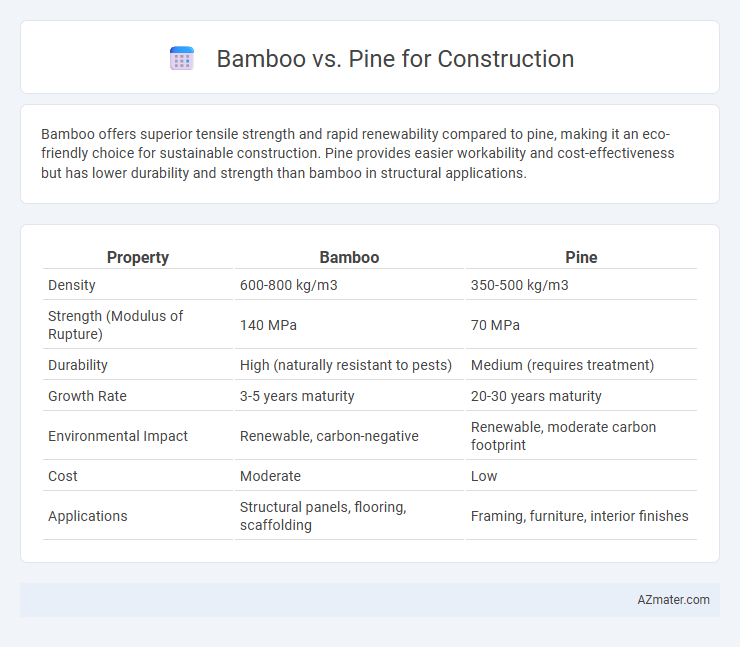Bamboo offers superior tensile strength and rapid renewability compared to pine, making it an eco-friendly choice for sustainable construction. Pine provides easier workability and cost-effectiveness but has lower durability and strength than bamboo in structural applications.
Table of Comparison
| Property | Bamboo | Pine |
|---|---|---|
| Density | 600-800 kg/m3 | 350-500 kg/m3 |
| Strength (Modulus of Rupture) | 140 MPa | 70 MPa |
| Durability | High (naturally resistant to pests) | Medium (requires treatment) |
| Growth Rate | 3-5 years maturity | 20-30 years maturity |
| Environmental Impact | Renewable, carbon-negative | Renewable, moderate carbon footprint |
| Cost | Moderate | Low |
| Applications | Structural panels, flooring, scaffolding | Framing, furniture, interior finishes |
Introduction to Bamboo and Pine as Construction Materials
Bamboo is a fast-growing, renewable grass known for its high tensile strength and flexibility, making it ideal for lightweight, sustainable construction projects. Pine, a softwood commonly used in construction, offers durability, ease of handling, and affordability, characterized by its straight grain and moderate density. Both materials provide distinct advantages, with bamboo excelling in eco-friendly applications and pine favored for traditional framing and structural uses.
Material Properties: Strength and Durability
Bamboo offers exceptional tensile strength and flexibility, making it highly resistant to bending and dynamic loads, while pine provides moderate strength with good compressive properties. Bamboo's natural silica content enhances its durability against pests and decay, surpassing pine which requires chemical treatment for improved resistance. For sustainable construction, bamboo's rapid growth and renewable nature combined with its superior strength-to-weight ratio make it an increasingly preferred material over traditional pine wood.
Sustainability and Environmental Impact
Bamboo offers a rapid growth cycle of 3-5 years, making it a highly renewable resource compared to pine, which typically takes decades to mature. Bamboo sequesters more carbon dioxide per hectare than pine forests, significantly mitigating greenhouse gas emissions in construction projects. Its natural durability and lower processing energy further reduce environmental impact, positioning bamboo as a sustainable alternative to traditional pine lumber.
Growth Rate and Harvesting Cycles
Bamboo exhibits an exceptionally rapid growth rate, reaching maturity within 3 to 5 years, while pine trees generally take 20 to 30 years to mature for harvesting. This accelerated growth and shorter harvesting cycle make bamboo a highly sustainable and renewable resource for construction purposes. Pine, although slower to grow, provides durable timber with consistent strength and is often preferred for structural applications requiring longer life span.
Cost Comparison: Bamboo vs Pine
Bamboo offers a cost-effective alternative to pine in construction due to its rapid growth rate and sustainable harvesting, reducing material expenses significantly. Pine, while widely available and traditionally used, often incurs higher costs linked to longer growth cycles and processing requirements. Long-term savings with bamboo are enhanced by its durability and lower maintenance needs compared to pine.
Workability and Ease of Use
Bamboo offers superior workability with its lightweight and flexible structure, allowing for quick cutting and shaping using basic tools, making it ideal for both traditional and modern construction. Pine, being a softwood, also provides ease of use due to its uniform texture and straight grain, which simplifies nailing, screwing, and sanding processes. However, bamboo's natural joints require specific handling techniques, whereas pine's consistent density ensures more predictable performance across various construction applications.
Applications in Modern Construction
Bamboo and pine are both popular materials in modern construction, with bamboo offering exceptional tensile strength and rapid growth, making it highly sustainable for frameworks, flooring, and decorative elements. Pine's versatility and ease of treatment allow its widespread use in structural support, furniture, and interior finishes, benefiting from its consistent grain and availability. Bamboo's natural resistance to pests and flexibility contrasts with pine's vulnerability but superior workability, influencing material choice based on specific project requirements and environmental considerations.
Resistance to Pests and Decay
Bamboo exhibits superior resistance to pests and decay compared to pine due to its natural antimicrobial silica content and rapid growth cycle, which reduces vulnerability to termites and fungal attacks. Pine, being a softer wood, requires chemical treatments to enhance its durability against moisture, rot, and insect damage but remains more susceptible to decay over time. Utilizing bamboo in construction offers a sustainable and pest-resistant alternative, especially in tropical and subtropical regions prone to high humidity and insect activity.
Aesthetic Qualities and Design Flexibility
Bamboo offers a unique, natural aesthetic with its smooth, uniform texture and warm golden hues, enhancing modern and eco-friendly architectural designs. Pine provides a versatile appearance with a range of knots and grain patterns, lending a rustic character suitable for traditional and contemporary interiors. Both materials allow for creative design flexibility, but bamboo's rapid growth and sustainability make it a favored choice for innovative, green construction projects.
Conclusion: Choosing the Right Material
Bamboo offers superior sustainability and rapid growth rates, making it an eco-friendly choice for construction projects focused on green building. Pine is widely available, cost-effective, and offers good structural strength but has a slower growth cycle and less environmental benefit. Selecting between bamboo and pine depends on project requirements such as durability, budget constraints, environmental impact, and intended use of the material.

Infographic: Bamboo vs Pine for Construction
 azmater.com
azmater.com